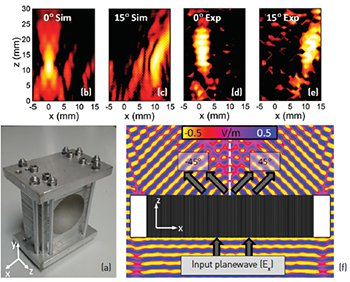 (a) Fabricated planoconcave ENZ lens. (b-c) Simulation and (d-e) experimental results of the normalized transmission under normal (b, d) and oblique (c, e) incidence. (f) Simulation results for the Ex-field on the xz-plane for an ENZ-GRIN power splitter designed to deflect an incoming plane wave to ±45° at its output.
(a) Fabricated planoconcave ENZ lens. (b-c) Simulation and (d-e) experimental results of the normalized transmission under normal (b, d) and oblique (c, e) incidence. (f) Simulation results for the Ex-field on the xz-plane for an ENZ-GRIN power splitter designed to deflect an incoming plane wave to ±45° at its output.
The arbitrary control of electromagnetic parameters allowed with human-made metamaterials provides opportunities to create exciting responses not found in nature. Materials with permittivity (ε) near-zero (ENZ) are becoming a very important subfield of research, because of their intriguing features such as near-infinite values of phase velocity (vp > c) and wavelength (λENZ > λ0) that enable light supercoupling, tunneling and squeezing.1 These features have been recently studied at near-infrared and visible frequencies using metal-dielectric-metal multilayers.2
Our research is centered on the use of these exciting metamaterials and on the development of different devices such as lenses, beam-steerers and power splitters. 3-5 The intrinsic dispersive response of a waveguide allows the emulation of an ENZ medium with the electromagnetic responses described above. We have used this property to synthesize ENZ media using narrow hollow rectangular waveguides, working near the cutoff frequency of the dominant mode.
We have studied and realized these devices analytically, numerically and experimentally. First, we demonstrated Fourier optics using an all-metallic planoconcave ENZ lens working at 0.144 THz (λ0~2.08 mm), designed using an array of waveguides with the same transverse (x and y) dimensions, but with different length (z dimension) to produce a concave profiled face. We evaluated the focusing properties of the lens by illuminating its planar face with a plane wave, demonstrating a transmission enhancement at the focus of 15.9 dB at the working frequency. The radiation performance showed a low transmission of the cross-polar component of −34 dB and a high directivity of 17.6 dBi.5 Placing the transmitter at different positions of the focal plane and measuring the far-field radiation pattern allowed us to mechanically steer the main lobe up to ±15°, demonstrating a wide angular response.4
Also, we were able to use the same artificial-medium principle to design beam-steerers (single angle) and power splitters (double angle), applying the graded-index (GRIN) technique. For these devices, the optical dimension was fixed for all the waveguides, while their aperture dimensions were engineered to change the direction of an incoming plane wave to different output angles.
Researchers
V. Pacheco-Peña, V. Torres, B. Orazbayev and M. Beruete, Universidad Pública de Navarra, Pamplona, Spain
M. Navarro-Cía, Imperial College London, London, U.K.
N. Engheta, University of Pennsylvania, Philadelphia, Pa., USA
References
1. M. Silveirinha and N. Engheta. Phys. Rev. Lett. 97, 157403 (2006).
2. R. Maas et al. Nat. Photon. 7, 907 (2013).
3. V. Pacheco-Peña et al. J. Opt. 16, 094009 (2014).
4. V. Pacheco-Peña et al. Appl. Phys. Lett. 105, 243503 (2014).
5. V. Torres et al. IEEE Trans. Antennas and Propagation 63, 1 (2015).
